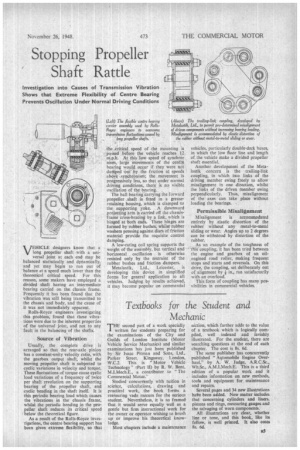Stopping Propeller Shaft Rattle
Page 39

If you've noticed an error in this article please click here to report it so we can fix it.
Investigation into Causes of Transmission Vibration Shows that Extreme Flexibility of Centre Bearing Prevents Oscillation Under Normal Driving Conditions
VEHICLE designers know that a long propeller shaft with a universal joint at each end may be balanced statistically and dynamically, and yet may begin to run out of balance at a speed much lower than the theoretical critical speed. For this reason, some makers have employed a divided shaft having an intermediate bearing carried on the chassis frame. Frequently it has been found that the vibration was still being transmitted to the chassis and body, and the cause of it was not immediately apparent.
Rolls-Royce engineers investigating this problem, found that these vibrations were due to the inherent properties of the universal joint, and not to any fault in the balancing of the shafts.
Source of Vibration
Usually, the complete drive is arranged so that the rear-axle pinion has a constant-unity velocity ratio, with the gearbox output shaft, whilst the moving propeller shaft is subjected to cyclic variations in velocity and torque. These fluctuations of torque cause cyclic load variations of a frequency of twice per shaft revolution on the supporting bearing of the propeller shaft, and cyclic bending in the shaft itself. It is this periodic bearing load which causes the vibrations in the chassis frame, whilst the periodic bending in the propeller shaft reduces its critical speed below the theoretical figure.
As a result of the Rolls-Royce investigations, the centre bearing support has been given extreme flexibility, so that
the critical speed of the mounting is passed before the vehicle reaches 12 m.p.h. At this low speed of synchro.? nism, large movements of the centre hearing would occur if they were not daMped out by the friction at speeds above synchrbnism; the movement is progressively less, so that under normal driving conditions, there is no visible oscillation of the bearing.
The ball bearing carrying the forward propeller .shaft is fitted in a greaseretaining housing, which is clamped to the supporting yoke. A downward projecting arm is carried off the chassisframe cross-bracing by a link, which is binged at both ends. These hinges are formed by rubber bushes, whilst rubber washers pressing against discs of friction material provide the requisite control damping. A low-rating coil spring supports the weight of the assembly, but vertical and horizontal oscillation is otherwise resisted only by the restraint of the rubber bushes and friction dampers.
Metalastik, Ltd., Leicester, is developing this device in simplified forms for general application to all vehicles. Judging by results achieved, it may become popular on commercial vehicles, particularly double-deck buses, in which the low floor line and length of the vehicle make a divided propeller shaft essential.
Another development of the Metalastik concern is the trailing-link coupling, in which two links of the driving member swing freely to allow misalignment in one direction, whilst the links of the driven member swing perpendicularly. Thus, misalignment of the axes can take place without loading the bearings.
Permissible Misalignment Misalignment is accommodated entirely by elastic distortion of the rubber without any metal-to-metal sliding or wear. Angles up to 2 degrees can be withstood by distortion of the rubber.
As an example of the toughness of this coupling, it has been tried between the engine and gearbox of an oilengined road roller, making frequent stops and starts and reversals. On this drive, the coupling, set deliberately out of alignment by in., ran satisfactorily with an overload.
This form of coupling has many possibilities in commercial vehicles.




















































































